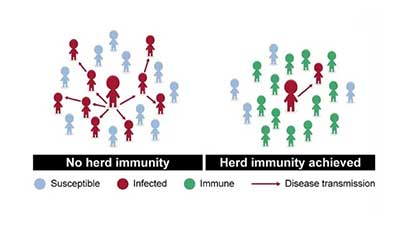Daily-current-affairs
/
19 Nov 2020
Herd Immunity : Daily Current Affairs

Herd Immunity
Why in News ?
- First sign of ‘herd immunity’ in small population groups is found in
Pune.
About
- In a first-of-its-kind finding for any Indian city, a new study
conducted in Pune has revealed that close to 85% of the people who had been
found infected with coronavirus in an earlier serosurvey had developed
protective antibodies. In effect, they had acquired immunity from the
disease.
- The latest finding is the result of a follow-up study done in five
prabhags (comprising three or four municipal wards each) of Pune where a
serosurvey conducted earlier this year, in July and August, had found that,
on an average, about 51% of the people had been infected with the virus.
- Serosurveys, like the ones carried out in several other cities as well,
estimate the extent of the disease spread by detecting antibodies among
surveyed population groups.
- However, the presence of antibodies only indicates that the person had
been infected with the disease at some point of time. It does not mean that
the infected person has also acquired immunity against the disease. Immunity
comes only if the infected person develops what is called ‘neutralising’ or
‘protective’ antibodies, a small sub-set of antibodies.
- This is the first study that followed up on an earlier serosurvey to
detect the presence of ‘neutralising’ antibodies in infected persons. And
though the researchers who carried out the study are careful not to suggest
that the city was approaching ‘herd immunity’, this is the first documented
case in the country where the infection rate in a population group had gone
up so high that the concept of herd immunity could already be playing out.
- Pune has so far reported 3.44 lakh confirmed cases of coronavirus
infections, the third highest for any city, after Delhi and Bengaluru. These
are the people who were tested and found to be positive. The city has also
recorded over 7,200 coronavirus-related deaths, the maximum after Mumbai and
Delhi.
What is herd immunity?
- Herd immunity refers to preventing an infectious disease from spreading
by immunising a certain percentage of the population. While the concept is
most commonly used in the context of vaccination, herd community can also be
achieved after enough people have become immune after being infected.
- The premise is that if a certain percentage of the population is immune,
members of that group can no longer infect another person. This breaks the
chain of infection through the community (“herd”), and prevents it from
reaching those who are the most vulnerable
How does herd immunity work?
- The scientific principle is that the presence of a large number of
immune persons in the community, who will interrupt the transmission,
provides indirect protection to those who are not immune.
- To estimate the extent of spread and immunity, epidemiologists use a
measure called the ‘basic reproductive number’ (R0). This indicates how many
persons will be infected when exposed to a single case; an R0 of more than 1
indicates one person can spread the infection to multiple persons.
- There are three ways in which an infection can spread in a community.
The first scenario looks at a community that is not immunised. When two
infectious cases, both with an R0 value of 1, are introduced, there is a
possibility of the entire community being infected, with a few exceptions.
- In the second scenario, there may be some persons who have been
immunised; and only these immunised persons will not be infected when at
least two infectious cases are introduced in the community.
- The third scenario is when the majority of the community is immunised.
So, when two infectious cases are introduced, the spread can take place only
in exceptional cases, like in the elderly or other vulnerable persons. Even
in such a situation, the immunised persons protect the non-immunised by
acting as a barrier — which is herd immunity.
What is Serosurvey?
- Serosurveys estimate the wider prevalence rate, because not every
infected person shows symptoms and gets tested.
- Seroprevalence studies (or serosurveys) estimate the share of the
population that test positive for antibodies using serology tests. The
presence of a specific antibody in a sufficiently high concentration will
suggest that the tested person was previously infected.
- Typically, such studies test individuals who are selected at random
using sampling techniques that will allow scaling the results to the general
population. You do not need to test everyone, or even a majority of the
population —what we need is a randomly drawn set of individuals, provided
that those who agree to participate in the test are not somehow
systematically different from those who refuse.







